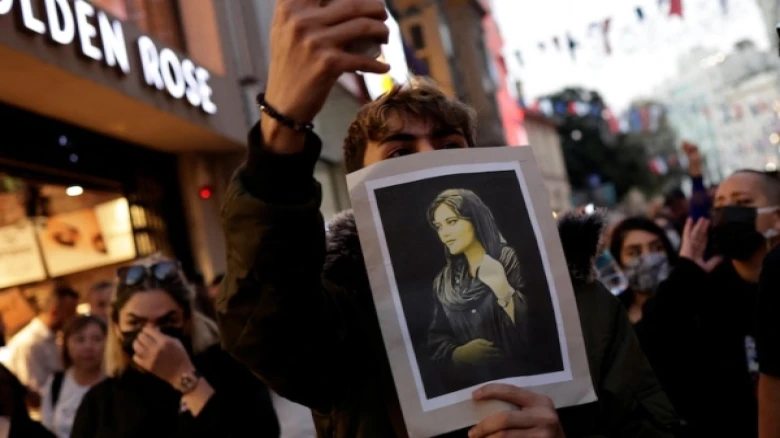Let's take a close look into the case and the long-running hijab controversy in Iran amid the protests and reports of a woman being beaten up by police, resulting in her death.
Digital Desk: As public uproar grows in Iran, three people were killed during protests over the murder of a young woman arrested by "morality police," who enforce a rigid dress code.
Mahsa Amini, 22, died in a hospital on Friday after three days in a coma after being arrested by Tehran's morality police on September 13 on a visit to the capital.
According to the New York Times reports, the police did not explain Amini's detention other than the hijab prohibition. Her mother told Iranian media that her daughter was following the regulations and was dressed in a long, loose robe. Despite his pleadings that they were tourists to the city, she claimed Amini was arrested as she departed the subway with her brother.
However, the incident sparked outrage across the country, sparking protests in Tehran, notably at many universities, and Mashhad, the country's second-largest city.
According to the reports, protesters marched down Hijab Street, or "headscarf street," in central Tehran, protesting the morality police.
What reasons led to the death of Mahsin Amini?
On Friday, state television aired a brief surveillance video of Amini falling in the police station after a disagreement with a policewoman. The victim's father, Amjad Amini, told Fars that he "didn't accept what (the police) showed him," claiming that "the film had been cut."
According to a statement made by Iran's security forces, Amini suffered a heart attack while being educated on hijab restrictions in the detention centre. Her family, however, denied this assertion, insisting that she was in wonderful health previous to her detention.
The victim's father also blamed the emergency services for their "slow response," saying, "I feel Mahsa was transferred to the hospital late." Interior Minister Ahmad Vahidi tweeted on Saturday that emergency personnel had responded "quickly." "on the site "Mahsa appears to have had previous physical problems, and we have reports that she had brain surgery when she was five years old." "Vahidi stated.
Fars said that her father "kept insisting that his daughter had no history of illness and was in great condition."
A photo and video of Amini, which showed her asleep on a hospital bed with tubes in her mouth and nose, blood flowing from her ear, and bruises around her eyes, went viral on social media.
While they didn't have access to her medical file, some Iranian doctors remarked on Twitter that blood from her ear suggested she had a concussion from head injuries.
The Outfits wearing rule in Iran
Morality police forces in the Islamic republic enforce a clothing rule that compels women to wear headscarves in public. Tight trousers, ripped jeans, knee-baring clothing, and vividly colored outfits are also prohibited.
It's not the first time that the Hijab controversy had arisen, Veiling in Muslim nations has always been significantly reliant on geographic, socioeconomic, and historical context, according to a Brookings analysis, and the subject has long been politicized in contemporary Iran.
According to a May 2018 BBC report, more than 35 female demonstrators have been jailed in Tehran alone since December 2017. According to the police, women who participate in anti-hijab protests face up to ten years in prison.
According to the BBC, a woman was grabbed and slapped by a female morality police officer in Tehran in April 2018 because of her loose headscarf. While not unusual, the incident was recorded and uploaded on Masih Alinejad's Instagram. It received over 30,000 comments and was viewed by over 3 million people.
Other Countries involved in the Hijab Controversies:
India- Six children were denied entry to a government school in the Udupi area last year due to their hijabs, which sparked uproar in India.
On Tuesday, the Karnataka High Court dismissed a number of petitions opposing the government decision banning the wearing of hijabs (headscarves) at schools and institutions.
Europe - In Europe, the hijab and burka controversies revolve around the various headdresses worn by Muslim women. In several countries, wearing a hijab (an Arabic noun meaning "to cover") has sparked political debate. Some countries already have laws prohibiting the wearing of masks in public.
European nations that have outlawed the hijab
Austria, France, Belgium, Denmark, Bulgaria, the Netherlands (in public schools, hospitals, and on public transportation), Germany (partial bans in some states), Italy (in some localities), Spain (in some localities of Catalonia), Russia (in the Stavropol Krai), Luxembourg, Switzerland, Norway (in nurseries, public schools, and universities), and Kosova have all outlawed the burqa completely or in part as of July 2021, according to a BBC report (in courts and other legal institutions).

Leave A Comment